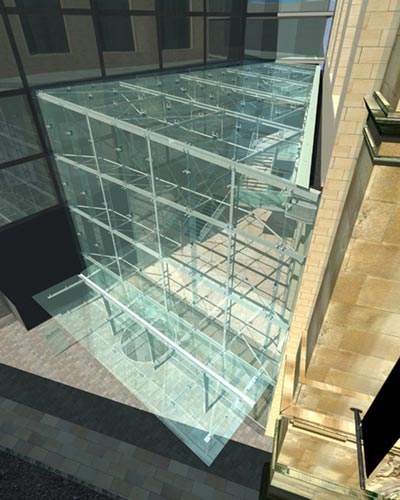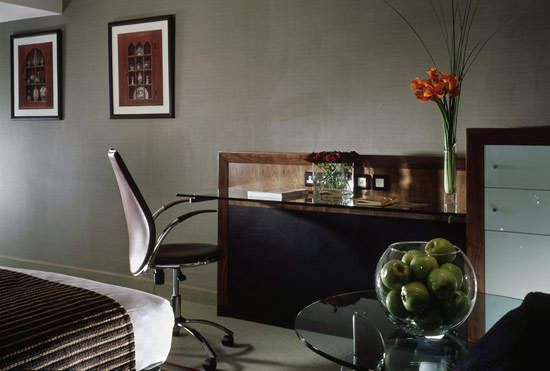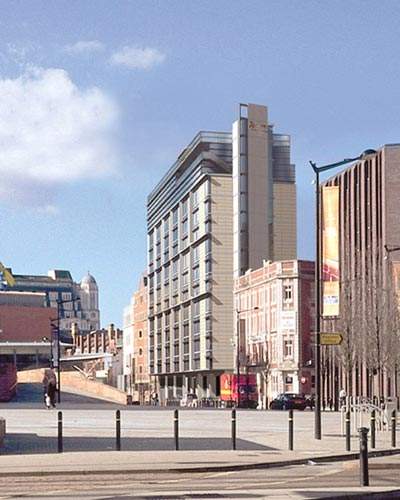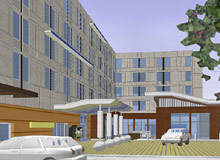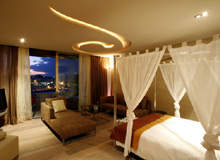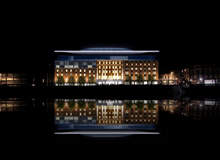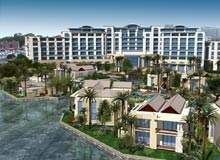Work began in 2002 on transforming the historic Free Trade Hall on Peters Street, Manchester, into a £45m luxury hotel after more than five years of negotiation over its controversial design. Radisson Edwardian Hotels is the operator of the new five-star hotel. This is Manchester’s only five-star hotel and has twice won hotel of the year at the Manchester tourist awards (2005 and 2006).
DEVELOPERS AND DESIGN CONTROVERSY
A major consortium represented by three of the UK’s biggest contractors/developers – Alfred McAlpine Special Projects, The O’Rourke Group and Laings – reached agreement with Manchester City Council to build the hotel complex in the heart of the city. The project is being funded by Bank of Scotland Corporate Banking in Manchester.
The hotel opened in October 2004, the construction having taken two years to complete. Care was taken during the design and construction to allow for the retention and enhancement of the feature Free Trade Hall building (grade II listed), which now provides the prominent facade for the hotel.
After much negotiation with the planning department of Manchester City Council, the design compromise reached has greatly enhanced the 1850s Walters facade on Peter Street. The Free Trade Hall was designed by Edward Walters between 1853 and 1856. A new 16-storey tower now replaces the previous buildings behind the Italianate frontage. The facade is original but the buildings behind it were built after the Second World War following bomb damage to the originals.
RADISSON CONSTRUCTION TIMETABLE
The hotel design is split into two blocks with an inter-joining glass atrium, the north block facing towards Peter Street and the south block facing on to Manchester Central (a complex of exhibition and conference spaces).
Over an eight-day period in October 2001, the Bagnall Group carried out a major asbestos removal strip out from the building prior to starting a complex demolition contract on the very confined site. Artefacts were recovered from the inside of the building to be included in the new development and eight large stone statues located on the rear external wall 30m above the highway were carefully dismantled and placed into storage for later use in the new development. The statues were of former conductors of the Halle Orchestra that used to be based in the Free Trade Hall up until 1996.
The basement slab, drainage and core base construction were all completed by the end of January 2003. On the south block, levels 1 and 2 were completed next. Each level was constructed using a structural concrete frame and each floor takes just six days to construct. This enabled work to commence on the bedroom blocks.
Levels 3 and 4 were completed by the end of May 2003. Construction of the bedroom blocks only took a period of approximately 13 to 14 weeks. Each bedroom was cast in a block of four and was cast in a single day, which in turn means that each complete floor was in place in a period of only one week. The north block was also completed by the end of May 2003.
FACILITIES AT RADISSON
The hotel is made up of north and south blocks each with 15 floors. The hotel offers 263 luxurious and comfortable bedrooms (83 king twin rooms, 154 king double rooms, 16 normal suites and four penthouse suites), a contemporary signature restaurant called Opus One, casual dining terrace restaurant called the Alto Terrace, cool bars, coffee shop, modern interiors and the latest technology to meet the needs of both leisure and business guests.
The hotel has a luxury health spa called the Sienna Spa, which has relaxation treatment stations in association with Elemis, swimming pool, Jacuzzi, steam rooms and fitness equipment (8,000ft² health club with seven treatment rooms) and an urban (Winter) garden that is accessible by the 20 ‘Al Fresco’ suites in the hotel each with their own private balcony. There are 18 meeting rooms and one conferencing room with unique features, such as natural daylight, accommodating from two to 400 people.
All rooms have high-speed and wireless internet access, Bang and Olufsen entertainment systems and advanced telephone systems. The hotel also features complimentary wireless internet access throughout and the Gentry Grooming Company.
Bathrooms are clad in Scandinavian slate and are divided into separate wet and dry areas; the wet area features a walk-in shower, bath and toilet, while the dry zone has a free standing wash bowl, a stylishly illuminated mirrored dressing area and walk-in wardrobe. The bedrooms also feature Percale cotton linen and original art works.
Scott Brownrigg was the international design company responsible for the bedrooms and the interior design of the hotel. The hotel budgeting and booking systems are controlled by a system supplied by EasyRMS.
REPLACING THE FREE TRADE HALL
The former home of the Halle Orchestra until July 1996, the Free Trade Hall was recognised as the city’s leading venue for classical music. Elgar’s First Symphony was premiered there in 1908. Many famous names have appeared at the hall, including Bob Dylan, Shirley Bassey, Ella Fitzgerald and the Sex Pistols.
To replace the ageing Free Trade Hall, Manchester wanted its new concert hall to be world-class, of a standard to enhance performances by the finest international orchestras. Arup provided geotechnical, structural and building services engineers in addition to acoustic engineers.
The new hall opened in 1996 and has seating for nearly 2,400 people. Rows of slender columns supporting a flat, coffered ceiling create the marvellous acoustic, while the seating is carefully tiered to draw the audience as closely as possible around and into the performance.

